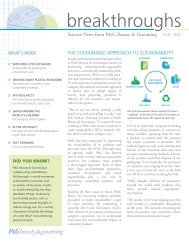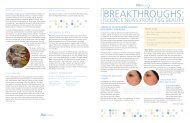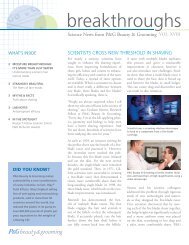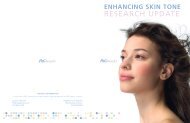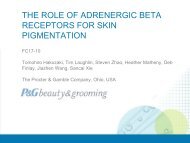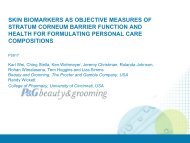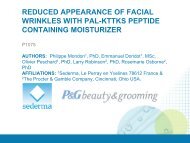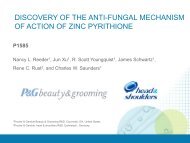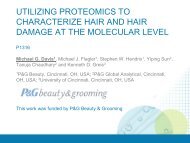Fine Lines, Wrinkles & Texture Research Update - P&G Beauty ...
Fine Lines, Wrinkles & Texture Research Update - P&G Beauty ...
Fine Lines, Wrinkles & Texture Research Update - P&G Beauty ...
Create successful ePaper yourself
Turn your PDF publications into a flip-book with our unique Google optimized e-Paper software.
study compared the sun-exposed skin<br />
of the forearm and the sun-unexposed<br />
skin of the buttocks in both<br />
young and older clinical test subjects.<br />
Gene chip technology allowed the<br />
researchers to identify exact processes<br />
and metabolic pathways that were<br />
diff erent in young versus old skin.<br />
Additionally, it allowed scientists to<br />
identify pathways that were active in<br />
young skin but were inactive in old<br />
skin as well as pathways that were<br />
overly active in the older skin, such<br />
as infl ammation.<br />
Genes observed in the older clinical<br />
test subjects shared consistent<br />
themes, including:<br />
• Immune and infl ammatory re -<br />
sponse genes were up-regulated<br />
• Extra-cellular matrix genes were<br />
up-regulated, though photoaging<br />
was more commonly associated<br />
with collagen gene changes and<br />
Summary<br />
<strong>Wrinkles</strong>, fi ne lines and uneven skin texture are<br />
persistent and universal concerns of aging patients, particularly<br />
women. But new innovations in topical treatments<br />
are allowing these concerns to be addressed both<br />
through preventative care, specifi cally the inclusion of<br />
ingredients that protect against UV-related damage,<br />
and restorative skin creams that deliver anti-aging<br />
benefi ts. Ingredients that have been shown to unequivocally<br />
deliver wrinkle, fi ne line and texture benefi ts<br />
include niacinamide, peptides, retinyl propionate and<br />
N-acetyl glucosamine.<br />
chronological skin aging with keratin<br />
gene changes<br />
• Protease/peptidase activity was upregulated<br />
• Oxidoreductase activity and epidermal<br />
development process genes<br />
were down-regulated<br />
Th e overarching theme, of course, is<br />
that an infl ammatory response was<br />
observed in older and photodamaged<br />
skin. By understanding how<br />
specifi c genes are modulated by the<br />
aging process, scientists now have the<br />
means to tailor treatments to shut<br />
down those processes which age the<br />
skin considerably.<br />
Th is study is just the beginning of<br />
the potential that is possible through<br />
gene chip technology. Th rough an<br />
analysis of these pathways at the gene<br />
expression level, these researchers<br />
are making discoveries that will ultimately<br />
lead to advances in cosmetic<br />
options for consumers. Spurred<br />
by the promising fi ndings to date,<br />
P&G <strong>Beauty</strong> scientists are continuing<br />
to explore this new frontier across<br />
multiple research end points. For<br />
the growing ranks of patients who<br />
seek non-invasive solutions to common<br />
dermatological problems, gene<br />
chip technology provides an understanding<br />
of skin aging never before<br />
possible, and, in doing so, off ers<br />
extraordinary potential for improving<br />
topical anti-aging treatments.<br />
This fi gure is illustrative of the combined effects<br />
of aging and photodamage at the gene expression<br />
level. The blue color indicates genes that<br />
are down-regulated; red, up-regulated; and white<br />
indicates no change. It is clear that there are large<br />
clusters of genes that are differentially regulated<br />
in young versus older photodamaged skin.<br />
Th rough refi ned applications of complex sciences and<br />
advanced technologies, P&G <strong>Beauty</strong> researchers are<br />
gaining a more complete picture of the underlying biological<br />
processes at work in aging skin. Th is methodological<br />
process has led to the ability to identify gene<br />
targets and tailor topical interventions accordingly. One<br />
dominant theme that has emerged is the age-related<br />
process of infl ammation, and thought leaders predict<br />
future anti-aging research and treatments will further<br />
expand upon and apply this body of knowledge.<br />
<strong>Fine</strong> <strong>Lines</strong>, <strong>Wrinkles</strong> and <strong>Texture</strong>: <strong>Research</strong> <strong>Update</strong> 17





